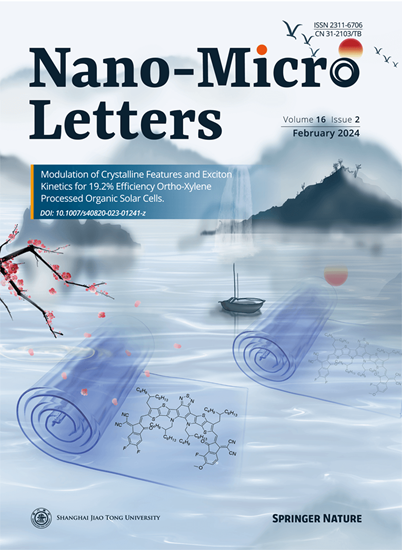增强 SiC@MoO3 纳米复合材料对电磁波吸收的缺陷诱导偶极极化策略
IF 26.6
1区 材料科学
Q1 Engineering
引用次数: 0
摘要
过渡金属氧化物半导体(TMOs)中的缺陷工程正引起人们的极大兴趣,因为它可以通过有意引入缺陷来调节材料的电子结构,从而增强导电性。然而,要全面了解微结构与电磁波吸收能力之间的关系仍然遥不可及,这对过渡金属氧化物吸波材料的发展构成了巨大挑战。目前的研究描述了在碳化硅纳米线上沉积氧化钼层的过程,该过程是通过电沉积后高温煅烧实现的。随后,研究人员有意识地在 MoO3 层中制造氧空位,从而精确调整电磁特性,提高材料的微波吸收性能。值得注意的是,在匹配厚度为 1.27 mm 时,SiC@MO-t4 样品的最小反射损耗为 - 50.49 dB。此外,厚度为 2.81 毫米的 SiC@MO-t6 样品显示出 8.72 千兆赫的有效吸收带宽,全面覆盖了整个 Ku 波段。这些结果不仅凸显了缺陷工程在细微调整电磁特性方面的关键作用,也为应用缺陷工程方法拓宽电磁波吸收频谱提供了宝贵的启示。通过原位刻蚀 SiC@MoO3 纳米复合材料,制备了具有不同氧空位浓度的 SiC@MO-t 样品。氧空位的存在在调整带隙和局部电子分布方面起着至关重要的作用,这反过来又增强了导电性损耗和诱导极化损耗能力。这一发现揭示了一种通过缺陷工程改善电磁波吸收特性的新策略。本文章由计算机程序翻译,如有差异,请以英文原文为准。

Enhancing Defect-Induced Dipole Polarization Strategy of SiC@MoO3 Nanocomposite Towards Electromagnetic Wave Absorption
Highlights
-
Oxygen-vacancy-rich SiC@MoO3 nanocomposite with strong reflection loss (− 50.49 dB at 1.27 mm thickness) and broadband absorption band (8.72 GHz at 2.68 mm thickness) were constructed via in situ etching strategy.
-
The presence of oxygen vacancy leads to an increased conductive loss and defect-induced dipole polarization, which plays significant role in attenuating the incident electromagnetic wave.
求助全文
通过发布文献求助,成功后即可免费获取论文全文。
去求助
来源期刊

Nano-Micro Letters
NANOSCIENCE & NANOTECHNOLOGY-MATERIALS SCIENCE, MULTIDISCIPLINARY
CiteScore
32.60
自引率
4.90%
发文量
981
审稿时长
1.1 months
期刊介绍:
Nano-Micro Letters is a peer-reviewed, international, interdisciplinary, and open-access journal published under the SpringerOpen brand.
Nano-Micro Letters focuses on the science, experiments, engineering, technologies, and applications of nano- or microscale structures and systems in various fields such as physics, chemistry, biology, material science, and pharmacy.It also explores the expanding interfaces between these fields.
Nano-Micro Letters particularly emphasizes the bottom-up approach in the length scale from nano to micro. This approach is crucial for achieving industrial applications in nanotechnology, as it involves the assembly, modification, and control of nanostructures on a microscale.
 求助内容:
求助内容: 应助结果提醒方式:
应助结果提醒方式:


